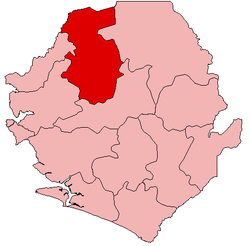Kalangba
| Kalangba Ngangba, (in Loko) | |
|---|---|
| Country |
|
| Province | Northern Province |
| District | Bombali District |
| Chiefdom | Gbendembu Ngowahun |
| Time zone | GMT (UTC+0) |
Kalangba is one of two chiefdom headquarter towns in the Gbendembu Ngowahun Chiefdom (an amalgamated Chiefdom), in the Bombali District, Northern Province of Sierra Leone. It is located on the Makeni-Kamakwei highway and about 15 miles north west of Makeni, Sierra Leone's Northern provincial city. Kalangba is a multicultural settlement with significant number of Loko, Fula and Mandingo. The people of Kalangba are primarily the Loko community, the fifth largest ethnic group in Sierra Leone, who are believed to have originated from Liberia. The name Kalangba has its origin from its founder, a fisherman known as Pa Ngangba. The British colonial administrators could not pronounce Ngangba well and so they called it Kalangba. Pa Ngangba was a member of the Loko tribesmen and used to fish along the waters of Manqwa, the name of a stream with literal meaning “if we cut ourselves” running through what is today known as Kalangba (or "Ngangba" in Loko).
Pa Ngangba’s comrade Pa Cigolo (Cigolo meant “spider” in Loko) settled on the other side of the town now used as a cemetery. A nearby settlement known as “Makambie” founded by a warrior called Kambie was merged with Kalangba. According to oral tradition, it is believed that the pre-colonial empire ruled by Bai Bureh, the hero of the Hut Tax War of 1898, extended from Kasseh in the Port Loko District to Kalangba.
Gumbu Smart, one of the heroes of Sierra Leone was born in this humble town.
The inhabitants are mostly engaged in unsustainable livelihood activities - agriculture, fishing and hunting - for sustenance. The town lacks most of the basic needs and services required for modern settlements. However, Kalangba has a Junior Secondary School and a Primary health center that serves the community and the peripheral villages. Kalangba also has two elementary schools, one founded by the American Wesleyan Mission in the late forties and the other by the Sierra Leone Muslim Brotherhood in the late seventies.
It is a very religious community with converts and traditional Christians and Muslims. The town has a majestic structure imposingly located at the center of the town, the Wesleyan Church with a capacity to host more than five hundred people. There is also a Baptist church and two Mosques.
The Settlement of Kalangba
Present day Kalangba is a merger of three prehistoric settlements - Macigolo on the north east, Mandagai on the south east and Makambi on the west. The Sesays, The Kargbos, The Fornahs and The Koromas had lived in those settlements. It was the era of the Trans Sahara Trade but up to the end of the Trade in the 17th Century, Kalangba was unknown because the Trade in its real time never effectively reached that part of Sierra Leone.
Between the 15th and 18th centuries, there were inter tribal conflicts all across West Africa from the Sahel to the coast lines. Much of that was felt in Kalangba with the arrival of a splinter group of the Manes from Mandimansa (Present day Mali) who invaded Sierra Leone in the 16th Century led by the great grandfather of the Kamaras, Pa Tegbehun. Pa Tegbehun, known in Ngowahun as the great warrior, established his control over the three settlements in the first half of the 19th Century from Gbangbawahun on the south side of Kalangba. At that time the expansion of the British Colony into the protectorate areas of Sierra Leone had just begun. However, Colonial relationship with Kalangba was actually felt during the era of Pa Tegbehun's successor, Yangi Saio, better known as Kandeh Saio II.
Yangi Saio came to power during the spread of Islam in West Africa. It was during the time of Yangi Saio the great Muslim cleric and prominent business man, Pa Alhaji Saccoh, arrived. It was also during the time of Yangi Saio the three settlements were merged. The American missionaries from Oklahoma who had been in Sierra Leone since the late 1800s also came to Kalangba during that period.
Between the era of Yangi Saio and Kandeh Saio III, power shifted to Gbendembu for a while but by the time Kandeh Saio III came to power, Kalangba had grown into a multicultural settlement. There were the Lokos, the Mandingoes, the Susu, the Fula, the Wolof, etc. The multiculturalism and increase in population was sped with the construction of road between Makeni and Kamakwei and establishment of the ferry system on Mabole River in the early 20th Century.
